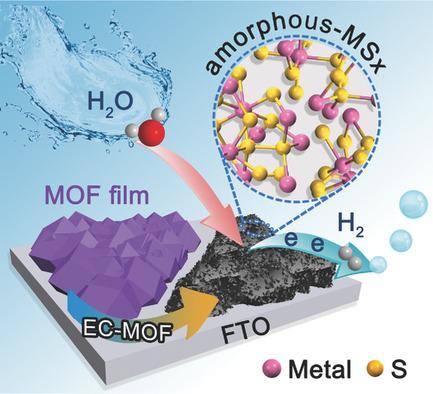当前位置:
X-MOL 学术
›
Adv. Funct. Mater.
›
论文详情
Our official English website, www.x-mol.net, welcomes your
feedback! (Note: you will need to create a separate account there.)
Room‐Temperature Electrochemical Conversion of Metal–Organic Frameworks into Porous Amorphous Metal Sulfides with Tailored Composition and Hydrogen Evolution Activity
Advanced Functional Materials ( IF 18.5 ) Pub Date : 2018-02-12 , DOI: 10.1002/adfm.201707244 Wenhui He 1 , Raya Ifraemov 1 , Arik Raslin 1 , Idan Hod 1
Advanced Functional Materials ( IF 18.5 ) Pub Date : 2018-02-12 , DOI: 10.1002/adfm.201707244 Wenhui He 1 , Raya Ifraemov 1 , Arik Raslin 1 , Idan Hod 1
Affiliation

|
The conversion of metal–organic frameworks (MOFs) into inorganic nanomaterials is considered as an attractive means to produce highly efficient electrocatalysts for alternative‐energy related applications. Yet, traditionally employed MOF‐conversion conditions (e.g., pyrolysis) commonly involve multiple complex high‐temperature reaction processes, which often make it challenging to control the composition, pore structure, and active‐sites of the MOF‐derived catalysts. Herein, a general, simple, room‐temperature method is presented for a controlled electrochemical conversion of MOF (EC‐MOF) films into porous, amorphous metal sulfides (a‐MSx). Detailed X‐ray photoelectron spectroscopy analysis and control over independent EC‐MOF parameters (e.g., scan‐rate and potential window) enable to gain insights on the MOF‐conversion mechanisms, and in turn to fine‐tune the porosity and composition of the obtained MSx. As a result, a highly active amorphous cobalt sulfide (a‐CoSx) electrocatalyst can be designed for hydrogen evolution reaction in neutral pH. Furthermore, the adjustable nature of the EC‐MOF method allows to draw conclusions about the correlation between the concentration of catalytically active species ( sites) and the hydrogen evolution properties of the a‐CoSx. Given the method's generality and the diversity of available MOF structures, EC‐MOF provides a compelling platform for a rational design of a wide variety of active electrocatalytic materials.
sites) and the hydrogen evolution properties of the a‐CoSx. Given the method's generality and the diversity of available MOF structures, EC‐MOF provides a compelling platform for a rational design of a wide variety of active electrocatalytic materials.
中文翻译:

金属-有机骨架在室温下电化学转化为多孔的无定形金属硫化物,具有定制的组成和析氢活性
金属有机骨架(MOF)向无机纳米材料的转化被认为是生产用于替代能源相关应用的高效电催化剂的一种有吸引力的手段。然而,传统上采用的MOF转化条件(例如热解)通常涉及多个复杂的高温反应过程,这常常使控制MOF衍生的催化剂的组成,孔结构和活性位点具有挑战性。本文介绍了一种通用的,简单的室温方法,用于将MOF(EC-MOF)膜受控地电化学转化为多孔的非晶态金属硫化物(a-MS x)。详细的X射线光电子能谱分析和对独立EC-MOF参数的控制(例如,扫描速率和电势窗口)使您能够洞悉MOF转换机制,进而微调所获得的孔隙度和组成MS x。结果,可以设计出一种高活性的非晶态硫化钴(a-CoS x)电催化剂,用于在中性pH值下的氢气析出反应。此外,EC-MOF方法的可调节性质允许得出关于催化活性物质( 位点)的浓度与a-CoS x的析氢特性之间的相关性的结论。。考虑到该方法的通用性和可用MOF结构的多样性,EC-MOF为合理设计各种活性电催化材料提供了一个引人注目的平台。
位点)的浓度与a-CoS x的析氢特性之间的相关性的结论。。考虑到该方法的通用性和可用MOF结构的多样性,EC-MOF为合理设计各种活性电催化材料提供了一个引人注目的平台。
更新日期:2018-02-12
 sites) and the hydrogen evolution properties of the a‐CoSx. Given the method's generality and the diversity of available MOF structures, EC‐MOF provides a compelling platform for a rational design of a wide variety of active electrocatalytic materials.
sites) and the hydrogen evolution properties of the a‐CoSx. Given the method's generality and the diversity of available MOF structures, EC‐MOF provides a compelling platform for a rational design of a wide variety of active electrocatalytic materials.
中文翻译:

金属-有机骨架在室温下电化学转化为多孔的无定形金属硫化物,具有定制的组成和析氢活性
金属有机骨架(MOF)向无机纳米材料的转化被认为是生产用于替代能源相关应用的高效电催化剂的一种有吸引力的手段。然而,传统上采用的MOF转化条件(例如热解)通常涉及多个复杂的高温反应过程,这常常使控制MOF衍生的催化剂的组成,孔结构和活性位点具有挑战性。本文介绍了一种通用的,简单的室温方法,用于将MOF(EC-MOF)膜受控地电化学转化为多孔的非晶态金属硫化物(a-MS x)。详细的X射线光电子能谱分析和对独立EC-MOF参数的控制(例如,扫描速率和电势窗口)使您能够洞悉MOF转换机制,进而微调所获得的孔隙度和组成MS x。结果,可以设计出一种高活性的非晶态硫化钴(a-CoS x)电催化剂,用于在中性pH值下的氢气析出反应。此外,EC-MOF方法的可调节性质允许得出关于催化活性物质(
 位点)的浓度与a-CoS x的析氢特性之间的相关性的结论。。考虑到该方法的通用性和可用MOF结构的多样性,EC-MOF为合理设计各种活性电催化材料提供了一个引人注目的平台。
位点)的浓度与a-CoS x的析氢特性之间的相关性的结论。。考虑到该方法的通用性和可用MOF结构的多样性,EC-MOF为合理设计各种活性电催化材料提供了一个引人注目的平台。











































 京公网安备 11010802027423号
京公网安备 11010802027423号